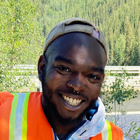Dakari Anderson
Location: Sacramento, CA
Office: WFO Sacramento
Job Title: Meteorologist
Educational Background:
- I have an undergraduate degree in Atmospheric Science from the University of Louisiana at Monroe and graduated in May 2020. I also just completed my final semester for an undergraduate degree in African-American Studies from North Carolina A&T this December.
Describe the career path that led you to your current job with the National Weather Service.
- I have always known I wanted to be a meteorologist, and it is the only career I have considered since elementary school. I had the great opportunity to shadow the forecasters at the NWS Jackson, MS Weather Forecast Office (WFO) during my senior year of college, and I knew this is the job I wanted to do.
What do you do for the NWS?
- I forecast for Northern Alaska, the largest landmass forecasted by a single office, so we get almost the entire spectrum of weather impacts, such as fire weather, river and coastal flooding, and winter weather. I lead the Outreach, Social Media, and Diversity teams in the office and serve as the Marine Program Backup Focal Point. Outside of our daily issuance of hazards and forecast updates, I publish a monthly office newsletter, The Tanana Times and run our school outreach program.
What was the most interesting, exciting, or impactful weather/water event you experienced while working for the NWS and why does it stand out?
- This fall, we had remnants of Merbok impact our West Coast communities with large swaths of the coast under the threat of coastal flooding with high storm surge and winds. It stands out because of the immense impact it brought to our coastline. There was even a point when doing the forecast I had to ask my lead forecaster if my computer was broken because I didn’t recognize the colors that were associated with such high storm surges. Additionally, it was the most collaborative forecast I have been a part of and am really proud of the work we did to get the message to vulnerable communities to ensure they responded to the weather threat.
What made you decide to pursue a career with the NWS?
- I knew I wanted to work with the public and working for the NWS has given me so many opportunities to bring weather to the communities. I get to visit schools or even work with our outreach team to create a weather map in Alaska Native languages. NWS also offers me many opportunities to learn diverse aspects of meteorology, whether it’s river flood forecasting, aviation, or extreme winter events. Every day presents itself with new challenges, with no two forecasts exactly the same.
What do you like most about working for the NWS?
- I love how much we get to interact with our public and directly meet the needs of our forecast area. It lets you see who the forecast is affecting and that we are not just sending the forecast into the void. Our decisions are being used by the public, and we get to have a daily impact on our public’s day-to-day decisions.
What advice do you have for someone interested in a career with the NWS?
- Be open and explore all the opportunities! Through my job here, I have been able to participate in activities like working a week-long climate summer camp in the Arctic or getting to performance measurements over frozen rivers and lakes in our area. There is so much more to our job than sitting behind a computer and submitting a forecast each day!
What training or coursework would you recommend to someone interested in following your career path?
- Science communication training and any opportunity to shadow an NWS employee would be my recommendations. Improving how to reach more people and explaining complicated weather concepts in simple terms better saves lives and property and is a huge component of our job. We can have a perfect forecast, but if it doesn’t reach the public clearly, then they still can’t respond safely to the potential hazards they may face.
